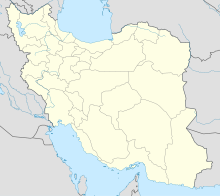Shimbar
Coordinates: 32 ° 39 ′ 0 ″ N , 49 ° 36 ′ 0 ″ E
Shimbar (also Tang-i Butan or Tang-i Shimbar ) is a valley in Chuzestan ( Iran , in the region of the ancient Elymais ), in which there are two Parthian rock reliefs and the remains of a building, perhaps a temple.
The first relief shows only a single standing male figure. She is about three feet tall, shown frontally, and wears trousers with a tunic over them.
The second relief, on the other hand, shows twelve men in a row, nine of them slightly larger than life, while three on the right side are shown slightly smaller. This relief consists of five groups, which were probably made one after the other and not at the same time. On the far left there are two figures, one of them naked. Next to the naked man stands a clothed man and there is the inscription wky, the elder, in the oath, son of Swl . An altar is shown between the two. The next group again shows a naked man and two clothed men on the right. Here, too, there are inscriptions, including Sptw , who is said to have created the pictures. The following group shows two figures, a naked man next to a clothed man. The inscription reads: Orodes, the great, in oath . The next group again shows a naked man next to a clothed man, while the last group of the relief shows three clothed men in a row. Her figures are a little smaller than the others (about 1, 10 m high), but, like all the others, are shown completely frontal.
The naked figure in the individual groups is likely to represent either Heracles (or Verethragna , who was equated with Heracles), whereby an altar of Baal is also mentioned in an inscription and it therefore seems not unlikely that Baal is reproduced here . The clothed figures are the donors of the relief, the second relief apparently being made in stages. Several donors have immortalized themselves here with their deity. There is little evidence of a dating of the reliefs; stylistically, they may belong to the second half of the second and the beginning of the third century after the birth of Christ.
literature
- Hans Erik Mathiesen: Sculpture in the Parthian Empire. Aarhus 1992, ISBN 87-7288-311-1 , pp. 125-130.
